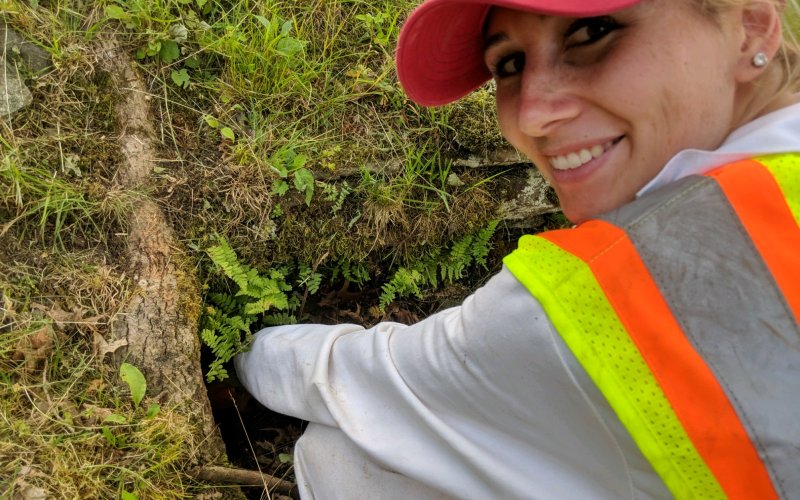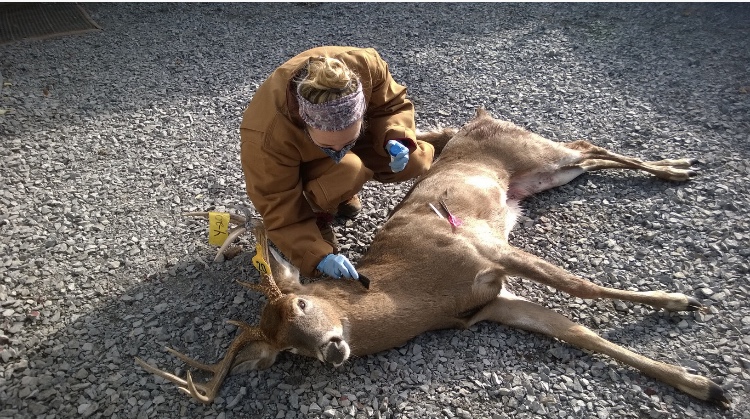Student Spotlight: PhD Student Rachel Lange on Powassan Virus

Rachel Lange is a 3rd year PhD student in the Department of Biomedical Sciences at the School of Public Health. She works in Alexander Ciota’s lab in the Arbovirus Laboratories at the New York State Department of Health (NYSDOH). She studies Powassan virus, which is spread to people through the bite of an infected tick. We sat down with Lange to learn more about her work.
How long have you been studying Powassan virus, and what do you find most fascinating/interesting about studying this topic?
I first started studying Powassan virus when I was an undergraduate at Syracuse University. I worked in the field with Dr. Brian Leydet at SUNY ESF to investigate the prevalence of Powassan virus amongst different tick species at a field site in Pennsylvania. I was essentially trying to collect Ixodes cookei, the groundhog tick, from groundhog burrows using a vacuum while also collecting Ixodes scapularis, the blacklegged tick, through standard flag and drag techniques that are used when conducting surveillance on tickborne pathogens.
This work really sparked my interest in the transmission cycles that Powassan virus is found in in nature. There are two lineages that are separated based on these ecological cycles in nature with lineage 1 maintained in the groundhog ticks and lineage 2 maintained in the blacklegged tick. Since I had also worked in an immunology lab at the time, I was always interested in how differences in tick species immune responses might influence how these viruses change and evolve.
This led me to coming to work with Dr. Alex Ciota, the director of the Arbovirus Laboratories at the NYSDOH. Here I’ve been asking that very question using the extensive collection of Powassan isolates we have going back to its discovery in 1958. With the ecological cycles in mind, when I entered graduate school the Arbovirus Lab detected the first lineage 1 Powassan isolate in the blacklegged tick (the tick that typically we only find carries lineage 2). This novel finding led to our most recent publication last December entitled “Identification and characterization of novel lineage 1 Powassan virus strains in New York State.”
You recently published a paper looking at a novel type of Powassan virus - by novel, how 'new' are we talking?
These unique lineage 1 strains I’ve been working with aren’t necessarily a new type of Powassan, but more so highlights that lineage 1 is found in transmission cycles beyond just the groundhog tick. The lineage 1 strains I studied collected from both groundhog and our novel blacklegged tick-derived strain are genetically and phenotypically distinct. This means there are differences in their RNA genome and their ability to infect mammalian (including humans) cells and experimentally infected ticks. Lineage 1 is so rarely isolated and found in the field that this paper is the first report of Powassan lineage 1 in New York State since 1975! It’s important to understand genotypes and phenotypes of these strains so we can predict high risk areas where we may need to target more preventative measures and also help with informing the clinical side to avoid misdiagnosis and better address therapeutic needs for Powassan infections in humans.
What journal was this published in?
You can find this article published in the journal of Emerging Microbes and Infections which typically includes research related to exciting emerging diseases!
Lange, R. E., Dupuis, A. P., Prusinski, M. A., Maffei, J. G., Koetzner, C. A., Ngo, K., ... & Ciota, A. T. (2022). Identification and characterization of novel lineage 1 Powassan virus strains in New York State. Emerging Microbes & Infections, (just-accepted), 1-19.
What were the main findings/insights of the paper?
This study is the first report of isolation of POWV lineage 1 from the blacklegged tick. Additionally, it is the first report of POWV lineage 1 isolations in New York since 1975. We also found these POWV lineage 1 strains are genetically and phenotypically distinct suggesting over time there has been diversification and spread of the virus in the state. Further, our I. scapularis-derived POWV lineage 1 strain exhibits adaptation to I. scapularis, that could additionally increase spread of the virus. This study, and our current unpublished work on POWV, highlight the importance of robust surveillance programs like that at NYSDOH to help predict the establishment and spread of tickborne pathogens.




